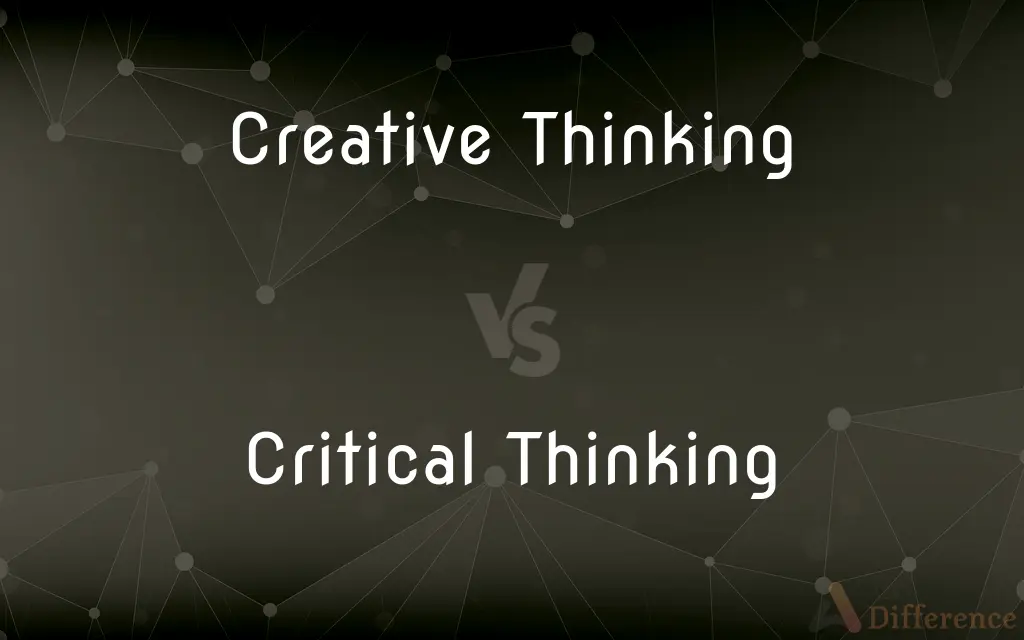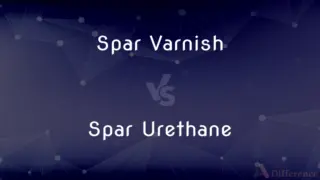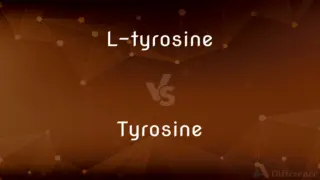Creative Thinking vs. Critical Thinking — What's the Difference?
By Urooj Arif & Fiza Rafique — Published on October 8, 2024
Creative thinking explores possibilities and generates innovative ideas, focusing on divergent thinking. Critical thinking evaluates information and arguments, emphasizing logical reasoning and convergent thinking to reach conclusions.

Difference Between Creative Thinking and Critical Thinking
Table of Contents
ADVERTISEMENT
Key Differences
Creative thinking involves looking at situations or problems from a fresh perspective to conceive new or unconventional solutions. It is characterized by the ability to generate multiple, diverse ideas—known as divergent thinking. Creative thinkers thrive on imagination and the potential for innovation, often asking "What if?" to push boundaries beyond traditional limits.
Critical thinking, in contrast, is the systematic process of evaluating information to make reasoned judgments. It relies on logic, objectivity, and analytical skills—termed convergent thinking—to deduce facts, assess validity, and solve problems by narrowing down the possibilities to the best solution.
Creative thinking encourages free flow of ideas and values originality and inventiveness, whereas critical thinking focuses on accuracy, validity, and reliability, seeking to identify biases, errors, or unfounded claims. Creative thinking is often associated with the generation phase of a process, where the goal is to brainstorm without limitation. Critical thinking is typically applied in the evaluation phase, where ideas are scrutinized, and decisions are made based on evidence and reasoning.
Both types of thinking are not mutually exclusive but complementary. For instance, in a problem-solving scenario, creative thinking can be used to generate a wide range of solutions, after which critical thinking can assess these solutions to choose the most effective one. This synergy is crucial in many fields, from science and engineering to arts and business, where innovation is guided by practicality and feasibility.
In the realm of education and professional development, fostering both creative and critical thinking skills is seen as essential for adapting to complexity, solving multifaceted problems, and driving progress. Encouraging creative thinking develops flexibility and openness to new ideas, while honing critical thinking skills enhances decision-making and reasoning abilities, preparing individuals to navigate the challenges of the modern world effectively.
ADVERTISEMENT
Comparison Chart
Objective
Generating innovative ideas and solutions
Evaluating information to make reasoned judgments
Key Characteristics
Divergent thinking, imagination, originality
Convergent thinking, logic, analytical skills
Focus
Possibilities, novelty, and inventiveness
Accuracy, validity, and reliability
Process
Ideation without immediate constraints
Systematic evaluation and deduction
Outcome
Multiple potential solutions
Best possible solution based on evidence
Role in Problem-Solving
Idea generation phase
Idea evaluation and decision-making phase
Application Fields
Arts, design, innovation, marketing
Science, mathematics, law, ethics
Complementary Nature
Often precedes critical thinking in processes
Follows creative thinking to refine ideas
Compare with Definitions
Creative Thinking
Ideation beyond conventional boundaries.
Using creative thinking, a designer imagines a chair that can transform into a ladder.
Critical Thinking
Seeks to establish truth and validity.
A judge applies critical thinking to assess the credibility of witness statements.
Creative Thinking
Values originality and novelty.
An artist uses creative thinking to develop a unique painting technique.
Critical Thinking
Involves structured reasoning.
An engineer uses critical thinking to choose the best material for a bridge.
Creative Thinking
Seeks to explore and expand.
A writer uses creative thinking to construct a fantasy world in their novel.
Critical Thinking
Identifies errors and biases.
A journalist uses critical thinking to debunk a false news story.
Creative Thinking
Generates diverse solutions.
Brainstorming sessions employ creative thinking to solve a company's branding challenge.
Critical Thinking
Aims for well-supported conclusions.
A policy analyst applies critical thinking to recommend a course of action.
Creative Thinking
Embraces risk-taking and innovation.
A marketer's creative thinking leads to a groundbreaking advertising campaign.
Critical Thinking
Evaluates information logically.
A scientist uses critical thinking to analyze experimental data.
Common Curiosities
Why is creative thinking important?
It drives innovation and progress by enabling the generation of new ideas and approaches to problems.
How does critical thinking benefit decision-making?
It ensures decisions are well-reasoned, logical, and based on a thorough analysis of available information, minimizing risks and errors.
Can creative and critical thinking be developed?
Yes, both can be enhanced through practice, training, and exposure to diverse perspectives and disciplines.
How do creative and critical thinking complement each other?
Creative thinking broadens the range of possibilities, while critical thinking narrows these down to the most viable options, combining innovation with feasibility.
In what fields are both creative and critical thinking equally important?
Fields such as architecture, engineering, business strategy, and education highly value the integration of both thinking processes for effective problem-solving and innovation.
What role does creative thinking play in science?
It is essential for hypothesis generation, envisioning novel experiments, and conceptualizing broader implications of scientific discoveries.
Can a problem be solved using only one type of thinking?
While some problems might lean more towards one type of thinking, combining both often leads to more comprehensive and innovative solutions.
How do educational systems incorporate these thinking skills?
Through curricula that encourage inquiry, problem-based learning, interdisciplinary projects, and opportunities for experimentation and analysis.
What impact does technology have on these thinking skills?
Technology can both aid and challenge these skills, providing tools for innovation and analysis while necessitating critical evaluation of information and creative use of new platforms.
Why is critical thinking crucial in the arts?
It aids in critiquing artworks, understanding artistic techniques and messages, and making informed judgments about art's social and cultural relevance.
How can one improve their creative and critical thinking skills?
Engaging in diverse intellectual activities, practicing brainstorming and analysis, seeking feedback, and learning from different fields can sharpen both skill sets.
Share Your Discovery

Previous Comparison
Spar Varnish vs. Spar Urethane
Next Comparison
L-tyrosine vs. TyrosineAuthor Spotlight
Written by
Urooj ArifUrooj is a skilled content writer at Ask Difference, known for her exceptional ability to simplify complex topics into engaging and informative content. With a passion for research and a flair for clear, concise writing, she consistently delivers articles that resonate with our diverse audience.
Co-written by
Fiza RafiqueFiza Rafique is a skilled content writer at AskDifference.com, where she meticulously refines and enhances written pieces. Drawing from her vast editorial expertise, Fiza ensures clarity, accuracy, and precision in every article. Passionate about language, she continually seeks to elevate the quality of content for readers worldwide.













































